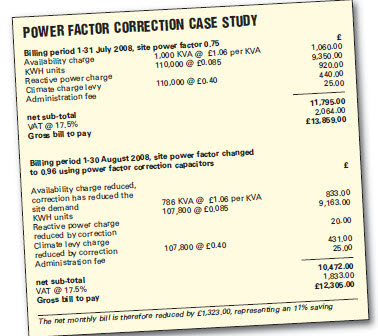Optimal Voltage
A few flickering lights may actually hint at an expensively-serious problem with the inefficiency of how all your electrical power supply is used. Power factor correction expert, Paul Caddick explains
Unhealthy flickering lights, blinking computer screens, the inconvenience of IT server disruptions, dangerously overheating cables and machinery requiring constant repairs. These are some of the common symptoms of power being used inefficiently and a source of high energy bills.
If you recognise any of those problems, you’re likely to be overdue a review of your power usage. This is because almost all of the problems can be checked and solved non-evasively with the potential to save many £000s in wasted energy. For a site where the electricity bill for one month was just under £12,000, our power factor corrections reduced the next month’s by 11 percent to total £16,000 within a year. Power quality in its broadest sense, is a set of boundaries that allows electrical systems to function in their intended manner without significant loss of performance or life. The term is used to describe electrical load and its ability to function properly with that power. Without the proper power, expect malfunction.
|
|
There are many ways in which electric power can be of poor quality and many more causes. The complexity of the system to move electric energy from the point of generation to consumption combined with influential variables such as the weather, provides many opportunities for compromise. While ‘power quality’ is a convenient term, it is actually the quality of the voltage, rather than the power or electric current that is of concern. Power is simply the flow of energy, while the current demanded by a load is largely uncontrollable.
Q&A
Problem: Many systems’ inefficiencies are due to high levels of non-linear loading by capacitors, motors and inductors. Circuits containing excessive amounts of non-linear equipment directly affect the power factor rating. In order to use the power supply efficiently, a power factor of 1.0 (unity) must be achieved. If rated at less, more energy is required. A prolonged implication of this is that the system will only use the required amount of power to function normally, so you still pay for the excess wasted in the form of KVAr’s. And because the supply authorities have to generate more energy than necessary, they not only charge for the excess, that excess is often charged at a premium rate!
Answer: After simply checking recent bills, a short period of monitoring the electricity supply will establish critical power readings to ultimately install power factor correction equipment where necessary. By achieving a power factor reading as close to 1.0 (unity) as possible, expect prolonged life expectancies of equipment and lower bills.
|
|
Problem: Overheating circuit breakers, neutral conductors, transformer windings or generator alternators, as well as excessive net billable kilowatt charges on the energy bills. These are all the likely result of harmonic distortion caused by high use of non-linear load equipment such as computers, electronic ballasts, compact fluorescent lamps and variable speed drives.
Answer: Simple monitoring over a short period of time will identify any harmonic distortion. An engineer will then establish the types of harmonics present, to identify solutions that can include special filters or to simply evaluate the replacement of equipment. Phase balancing exercises can even be carried out within distribution boards making equipment run more efficiently and reducing energy bills.
Problem: Overheating motors within a 3-phase system, where the voltages are unbalanced. If the difference between the highest and lowest voltage exceeds 4 percent of the latter, this is very likely the cause of any intermittent shutdown of motor controllers. However, many overload relays cannot sense the overheating.
Answer: If simple load tests carried out by an engineer reveal any imbalances, terminating circuits where necessary on the board can rectify these. These will distribute the demands more equally. This action can also reduce the presence of total harmonic distortion, subsequently reducing the threat of dangerous neutral currents that can lead to damaged cables, equipment and unplanned outages.
Problem: Excessive power used by 220V-rated appliances from the UK’s nominal 230 voltage, again causing overheating and reduced lifespan. Answer: Voltage optimisation is a technical term for some basic calculations and subsequent installation of purpose-built equipment that continuously regulates the voltage, to eliminate the power losses that raise the energy bills. While power quality surveys help heavily plantdependent industries tackle soaring energy costs, they also enable environmentally-motivated public sector organisations to meet the requirements of the Display Energy Certificates (DECs) for buildings with over 1,000m2 of floorspace. The increased lifespan to expect of plant from better power quality provides major subsequent financial gains. It also creates a safer workplace.
Paul Caddick is the MD of CLM Group Ltd

